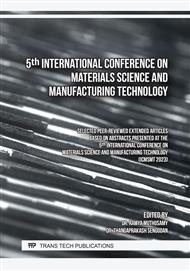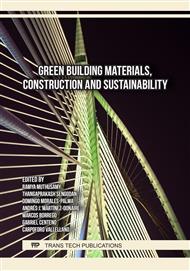[1]
J. Sivasubramanian & Y. Gino (2019), "Effect of Sodium Silicate on Hardening Property of Concrete", International Journal of Civil Engineering and Technology (IJCIET) Volume 10, Issue 05, May 2019, pp.642-650, Article ID: IJCIET_10_05_067 (Available online at http://iaeme.com/Home/issue/IJCIET?Volume=10&Issue=5) ISSN Print: 0976-6308 and ISSN Online: 0976-6316.
DOI: 10.34218/ijciet.11.6.2020.012
Google Scholar
[2]
R. Karthika & Dr. S. Senthil Selvan (2018), "Study on the Strength Characteristics of Concrete by Partial Replacement of Cement with Fly Ash and Addition of Sodium Silicate", International Journal of Applied Engineering Research ISSN 0973-4562 Volume 13, Number 10 (2018) pp.7412-7415.
Google Scholar
[3]
Marushchak U.D., Rusyn B.G. and Mazurak T.A., (2014), "Rapid Hardening Modified Concretes", Lviv Polytechnic National University, 121-124. (UDC 691.328)
DOI: 10.31734/architecture2018.19.090
Google Scholar
[4]
A. Kanellopoulos, P. Giannaros, D. Palmer, A. Kerr, A. Al-Tabbaa (2017), "Polymeric microcapsules with switchable mechanical properties for self-healing concrete: synthesis, characterisation and proof of concept", Smart Mater. Struct. 26 (4) (2017), 045025 (15pp).
DOI: 10.1088/1361-665X/aa516c
Google Scholar
[5]
Kurdowski W (2010), "Chemistry of cement and concrete", Scientific Publishing PWN. – Warszawа, 2010. – 728 р (
Google Scholar
[6]
M. Pelletier, R. Brown, A. Shukla, A. Bose, Self-Healing Concrete with a Microencapsulated Healing Agent, Kingston, USA, 2011.
Google Scholar
[7]
Jinxi Zhang, Jiangang Wang, Xinghai Li, Tongju Zhou and Yangyang Guo (2018), Rapid Hardening controlled low strength materials made of recycled fine aggregate from Construction and Demolition waste", Construction and Building Materials, Elsevier, 81-89.
DOI: 10.1016/j.conbuildmat.2018.04.023
Google Scholar
[8]
Balaguru and Dharm Bhatt, 2000, ―Rapid Hardening Concrete‖, Center for Advanced Infrastructure and Technology, Civil & Environmental Engineering.
Google Scholar
[9]
Dr. Shanthappa B. C, Dr. Prahallada. M. C. and Dr. Prakash. K. B., "Effect of Addition of Combination of Admixtures on the Properties of Self Compacting Concrete Subjected to Alternate Wetting and Drying", International Journal of Civil Engineering & Technology (IJCIET), Volume 2, Issue 1, (2011)
Google Scholar
[10]
M. VijayaSekhar Reddy, Dr.I.V. Ramana Reddy and N. Krishna Murthy, "Experimental Evaluation of the Durability Properties of High-Performance Concrete using Admixtures", International Journal of Advanced Research in Engineering & Technology (IJARET), Volume 4, Issue 1, 2013, pp.96-104
Google Scholar
[11]
Vinod P, Lalumangal and Jeenu G, "Durability Studies on High Strength High Performance Concrete", International Journal of Civil Engineering & Technology (IJCIET), Volume 4, Issue 1, 2013, pp.16-25
Google Scholar
[12]
Ali S. Faris, Riadh Al-Mahaidi and Awad Jadooe, Implementation of Magnetized Water to Improve the Properties of Concrete, International Journal of Civil Engineering & Technology (IJCIET), Volume 5, Issue 10, 2014, pp.43-57.
Google Scholar
[13]
Akula Prakash and Rathod Ravinder (2018), "Properties of Self Compacting Concrete with Peri-Shuttering Technology, Indian journal for scientific technology",17(2), 327-329 , ISSN NO:0976-2876 ISSN:2250-0138
Google Scholar
[14]
Akula Prakash, A.N. Swaminathen, Akoju Ramu, Bypaneni Krishna Chaitanya (2021), "Assessment of strength and durability parameters for concrete with partial replacement of coarse aggregates by iron slag and glass powder as an additive", 3rd International Conference on trends in Material Science and Inventive Materials (ICTMIM 2021) 12th-13th March 2021, Coimbatore, India. Volume : 1126 (2021)
DOI: 10.1088/1757-899X/1126/1/012082
Google Scholar
[15]
Magudeaswaran P, M.Palanisamy, Akula Prakash, Srikanth T (2021), "Durability studies on Geopolymer Mortar Cubes and their Impact Strength characteristics of Geopolymer Ferrocement Panels", 3rd International Conference on Inventive Research in Material Science and Technology (ICIRMCT 2021) 22nd-23rd January 2021, Coimbatore, India. Volume : 1091 (2021) 012069
DOI: 10.1088/1757-899X/1091/1/012069
Google Scholar
[16]
Akula Prakash, A.Varsha, Ch. Shailaja, A. Shivaleela and Ch. Swapna (2019) "Reducing Construction and Demolition Waste through Reuse and Recycling (Replacement of Fine Aggregate by Demolition Waste Concrete)", 6th National Conference on Water, Environment & Society (NCWES - 2019), 5 – 7 June 2019, ISBN: 978-93-88305-98-3, Page : 288-296
Google Scholar
[17]
Rathod Ravinder, Vivek Kumar C., Akula Prakash, A.Vittalaiah and P.V.V.S.S.R Krishna (2019) "Strength Characteristics of Fibrous Self Curing Concrete Using Super Absorbent Polymer" National Conference on Recent Advances in Civil Engineering (NCRACE-2019), 28th June 2019, ISBN: 978-93-8830-599-0, Page : 1 – 9
Google Scholar
[18]
IS 456 2000 IS 456-2000 Code of practice plain reinforcement concrete.
Google Scholar
[19]
IS 1199-1959 Code for Methods of sampling and analysis of concrete.
Google Scholar
[20]
IS 102062-Concrete Mix Proportioning guidelines.
Google Scholar



